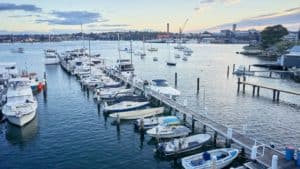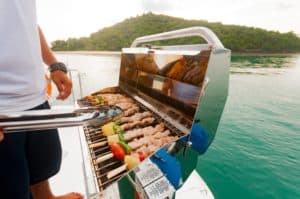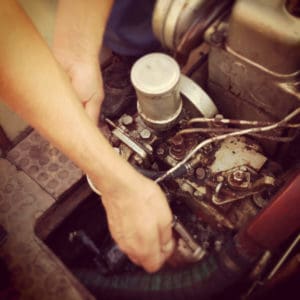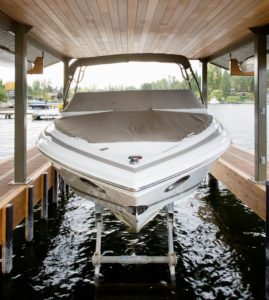Summer always seems to come and go fast, and before you know it, you are preparing your boat for winter. During this time, it’s important to start figuring out how and when you want to antifoul your boat.
Typically, antifouling is vital to your boat’s hull, especially when your boat will be stored in water. Antifouling makes it so that marine life won’t start to build upon the boat’s bottom and running gear. There are nuances to consider with antifouling (salt- vs freshwater, multiseason vs standard paint, etc), but we are here to help you understand all of them.
What is antifouling? We are here to help you understand and get your boat where it needs to be so that you don’t have to worry about the adverse side effects of marine growth build-up on your boat.
What Is Antifouling?
It might not come as a surprise, but antifouling is a way of protecting your boat when you are storing it in water. Typically, it is in the form of a paint that you apply to the hull, prop, and any other submerged parts of your vessel, which makes it hard for marine life to grow the surface — such as algae, barnacles, and tube worms.
Why Is Antifouling Important?
If you are planning to store your boat in water, then proper antifouling may just be the most important thing you do. By not antifouling your boat, you allow for things like marine growth and deposits from seawater to build upon the bottom of your boat. This can affect things like your boat’s speed and performance, as well as fuel efficiency. Accumulating high levels of marine growth can slow down powerboats by 5 knots and create a fuel consumption of 30%.
How Many Times Should I Antifoul My Boat?
How often you antifoul will be determined by how often you use and store your boat. If your boat is used regularly and you always keep it stored in water, this could be more frequent than if it was held on land and rarely used. If you do have your boat in water often, then minimally, it should be antifouled annually. In contrast, if your boat is stored ashore, you would be safe going every other year without antifouling your boat.
Everything You Need To Know About Antifouling Paint
You now know the importance of antifouling, but what exactly do you need to know about the paint? At Corleone Marinas, we have done the research and have got you covered.
What Makes Antifouling Paint Special?
Antifoul paint isn’t just standard resin that makes your boat look shiny. Antifouling paint is made up of a unique combination of chemicals to protect your boat from marine life. These chemicals include biocides and copper, which work together to block organisms from growing on the bottom of your vessel.
However, there are different kinds of antifoul paint — the material and type of your hull will determine which is used. The sort of paint you use is also determined by the type of water you sail (salt- vs freshwater)..
The four common ingredients that you can find in antifouling paint are:Solvent
- Resin
- Biocide
- Pigment
There are also two main categories for antifouling paint. They are hard bottom paint and ablative bottom paint.
Hard Bottom Paint
Hard bottom paint contains a higher level of biocide, making it more effective than soft bottom paint at repelling marine growth. The beauty of hard bottom paint is that it offers users a rigid surface with an excellent finish. It is used often by racing boats and is more expensive than soft bottom paint.
However, if you trailer your boat or take it out of the water regularly, hard bottom paint is not the best option for you. Due to the nature of the chemical composition of hard bottom paint, it oxidises quickly once introduced to the air, and the efficacy of the biocides within is greatly reduced.
Ablative Paint
Ablative paint is meant to wear off over time. It will start off wearing off on the outer part of your boat; however, it will still retain elements of the layers of biocide. This antifouling paint is suitable for many types of environments and can be used for just a single season or many seasons.
Ablative paint is a newer technology than hard bottom paint and is the paint of choice for a great many boating enthusiasts, due to its flexibility of use. If you occasionally (or often) trailer your boat, ablative paint is a much better choice, as its chemical composition allows for it to be exposed to air and still be just as effective once put back into service in the water.
This is due to the controlled sloughing of the coating, which allows for the outer layer (which becomes oxidised once introduced to the air) to be shed once back in the water, exposing the fresh, unoxidised paint to be exposed and continue protecting your boat.
What Should I Consider When Applying Antifouling?
When you decide how and when to antifoul your boat, you should consider a few different factors. First, you should think about the hull of your boat and the material it is made out of. Next, you should consider which type of water your boat will be stored in. Finally, consider whether or not you will be hauling your boat in and out of the water often, as this will help you decide whether to go for hard or ablative antifouling paint.
Let Us Help With Your Antifouling Needs
Corleone Marina at the Balmain Marina has one of the last remaining slipways in Sydney Harbour. Our marina services include the best antifouling and hull and boat repairs. We also offer Do-It-Yourself slip way usage on the weekends. We know you just want to get out and enjoy your boat, so let us help with those routine sailing maintenance issues so you can focus on enjoying your vessel.
Contact us today to find out more about our excellent marina services in four stunning Sydney locations. We’ll take good care of you and your boat so you can relax and enjoy sailing worry-free.









